
20 Eye-Opening Augmented Reality Statistics & Facts in 2022
AR Statistics: Market Overview
1. $50B AR market value is expected by 2024. (ThreeKit)
Augmented reality numbers have been growing for the last decade in a fast-paced manner.
In 2021, the worldwide AR market was estimated at only $25B. The core reason for rapid growth is an ideal product-market fit balance that stimulates the industry.
Brands adopt new AR-powered solutions like face filters, video editors, virtual try-on features, and many others. In turn, customers get a unique and user-oriented digital experience that meets their needs way more effectively than traditional market offerings.
This win-win strategy keeps both market sides motivated to release and consume new AR-powered solutions. And this approach is a core accelerator for growing AR trends.
2. In 2022, mobile augmented reality revenue is estimated to reach $12.8 billion. (Statista)
The number of worldwide mobile users is growing and tends to reach 7.49 billion in 2022. This means the native mobile app experience is among the core platforms for businesses to interact with their customers.
And AR adoption is no exception as brands don’t want to lose their mobile target audience. So, companies adopt augmented reality solutions and integrate them into their business apps to meet a large demand.
And this has a proven outcome: the global mobile AR revenue is projected to reach $12.8B in 2022 compared to only $4B in 2019.
3. 9 in 10 medium-sized brands are using augmented reality to power their business (Deloitte)
The research states that 88% of midsize companies leverage AR capabilities for multiple purposes.
Effective product development, fostering collaboration, accelerated training, goal-oriented marketing, and enhanced internal communication are among the core reasons companies adopt augmented reality.
For example, Ulta. The beauty and cosmetics company integrated an AR-powered virtual try on feature and let users try products in real-time before purchasing.
This helped the brand to increase sales, decrease the return rate, and skyrocket user engagement by 700%.
4. 75% of the global population will become active AR users by 2025 (Snap Inc.)
Deloitte Digital x Snap Inc. reported that 200M users actively engage with augmented reality on Snapchat daily. The third largest social media platform in the US predicts that over 75% of global shoppers will become active AR users by 2025.
These augmented reality usage statistics show that AR is thriving and more brands will invest to gain AR benefits.
Augmented Reality Statistics: Customer Behavior
5. 2 in 3 customers say they would purchase more products if they used AR (ThinkMobiles)
Multiple e-commerce, retail, healthcare, gaming, and automotive brands are adopting AR-powered technologies and rolling out new and disruptive solutions.
In turn, customers try and validate them mostly getting diverse benefits of AR compared to using traditional and old-fashioned market offerings.
Here comes a higher demand from users and increased sales for brands that motivates them to roll out new immersive experiences.
6. 6 in 10 customers state they prefer retailers with AR experiences (ThreeKit)
Virtual try-on solutions are among the core augmented reality-based experiences adopted by brands and liked by customers.
The augmented reality statistics study says immersive virtual try-on features help companies decrease the return rate by almost 30%. (ThreeKit)
These proven AR numbers show how AR-powered products benefit both market sides. And this is vivid as AR enables brands to offer an engaging try-before-buy experience.
Customers no longer need to visit offline stores and struggle with possible product fit problems. Users can seamlessly try on clothes, and appliances and even match desired furniture objects to their bedrooms or kitchens.
7. 40% of customers state would pay more for goods if they could customize them in AR (ThreeKit)
Multiple worldwide brands adopt AR-enabled customization features to offer a way more user-oriented approach for customers.
For example, Gucci.
Banuba helped the company integrate a virtual try-on feature with AR customization and effects into their mobile application.
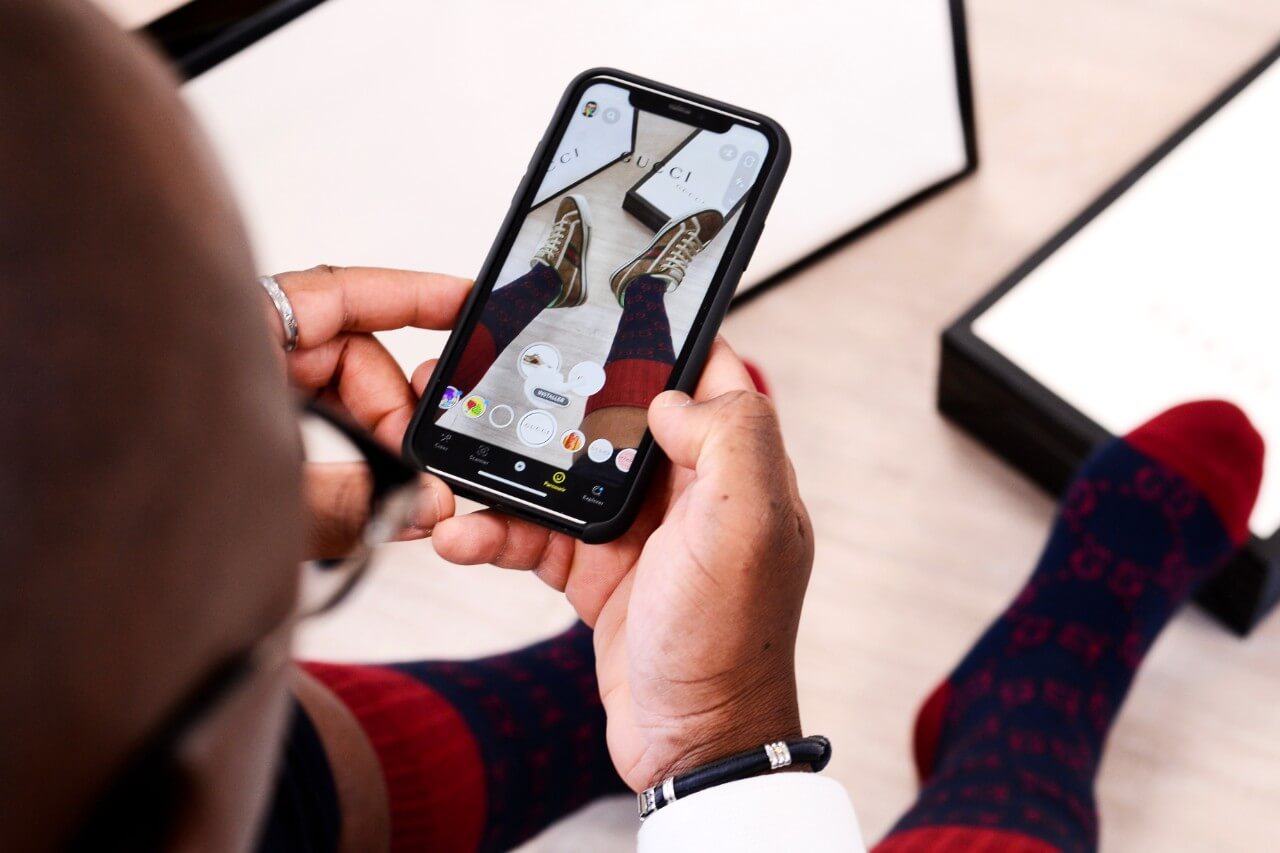 Gucci | Augmented Reality Statistics
Gucci | Augmented Reality Statistics
This way, users can now browse desired items, try them and even customize them in real-time in a single app. This one-of-a-kind experience helped Gucci skyrocket sales and decrease the product return rate by times.
Real-time AR customizations help customers make sure they get what they need and stimulate to choose AR-enabled companies that meet their fast-growing needs.
8. 2 in 3 users state AR can help them achieve new soft and hard skills (ISACA)
These AR numbers have two proven explanations: AR training and immersive social experience.
AR-powered training replaces traditional approaches to educating and learning. Trainee workers no longer need to process bulky documentation and manuals, and even have materials physically.
Augmented reality brings engaging digital environments, visually-appealing virtual snippets, and real-time access. These benefits motivate workers to stay engaged and gain new relevant hard skills.
Another yet powerful outcome is leveraging new soft skills.
Augmented reality brings face filters, gamification, video editing, and AR effects that help users communicate in a fully new and immersive way.
AR-powered solutions are proven to increase the amount of user-generated content which means users interact more, engage stronger, and communicate better.
For example, Banuba helped Chingari, an India-based social media platform, get 30M downloads and increase user engagement by times. With the help of AR-based Video Editor SDK, the company lets users create short TikTok-like videos and share them across multiple channels.
This use case shows how augmented reality can benefit both your brand and customers.
Augmented Reality Industry Recap
9. $6.4B is the estimated market value for the AR gaming industry in 2021. (IMARC)
The gaming augmented reality industry is among the largest domains adopting augmented reality technologies.
Pokemon Go, Harry Potter: Wizards Unite, Zombies, Run!, The Walking Dead: Our World and Jurassic World Alive enter the list of the most popular mobile AR games.
There are two main industry growth drivers: a rising number of mobile users and a huge demand for new gaming experiences.
Augmented reality makes the gaming industry thrive as players get a never-seen-before engagement. AR helps users simply integrate virtual characters and gaming scenarios into their real life helping brands increase the average session time and boost in-game monetization.
For example, Hyperspeed.
Banuba helped Teatime Games launch a first-of-a-kind AR-powered mobile game and disrupt the social gaming augmented reality industry.
With the help of our Face Filter SDK, Hyperspeed leveraged the Effect Constructor and Viewer components to integrate AR filters, effects, masks, and other animations in both real-time and post-processing.
This way, AR helped the gaming brand get over 50,000 downloads and raise $9M Series A funding.
![]() Hyperspeed Results | Augmented Reality Statistics
Hyperspeed Results | Augmented Reality Statistics
10. $337B is the estimated market value for the AR automotive industry by 2025 (Statista).
The automotive industry is another large market player leveraging multiple benefits of AR. The top use cases include:
Automotive companies benefit from adopting augmented reality both internally and externally.
For example, BMW. One of the world-leading multinational corporate manufacturers of luxury vehicles, BMW was among the first players to utilize AR-based capabilities and assist their manufacturing technicians.
The company adopted AR-powered solutions to inspect delivered parts within its Toolmaking and Plant Engineering departments. The software helped workers generate accurate data on each tool including its drill holes and clear surface features.
This experience helped decrease the human factor error by benchmarking each tool before using it. Technically, algorithms process each image using around 50 criteria. In case there was no match with the set specifications, technicians reworked the tool before sending it to the assembly area.
11. $4B is the estimated market value of AR healthcare solutions by 2026. (GlobeNewswire)
Healthcare companies make over 30% of the global augmented reality market value. The core AR healthcare use cases include:
For example, PerSim.
It’s a realistic AR-based simulator software that helps EMTs, paramedics, and others to deal with real-life causes virtually. From trauma-related injuries to mass casualty events, professionals use the strengths of AR to learn, practice, and grow hard skills.
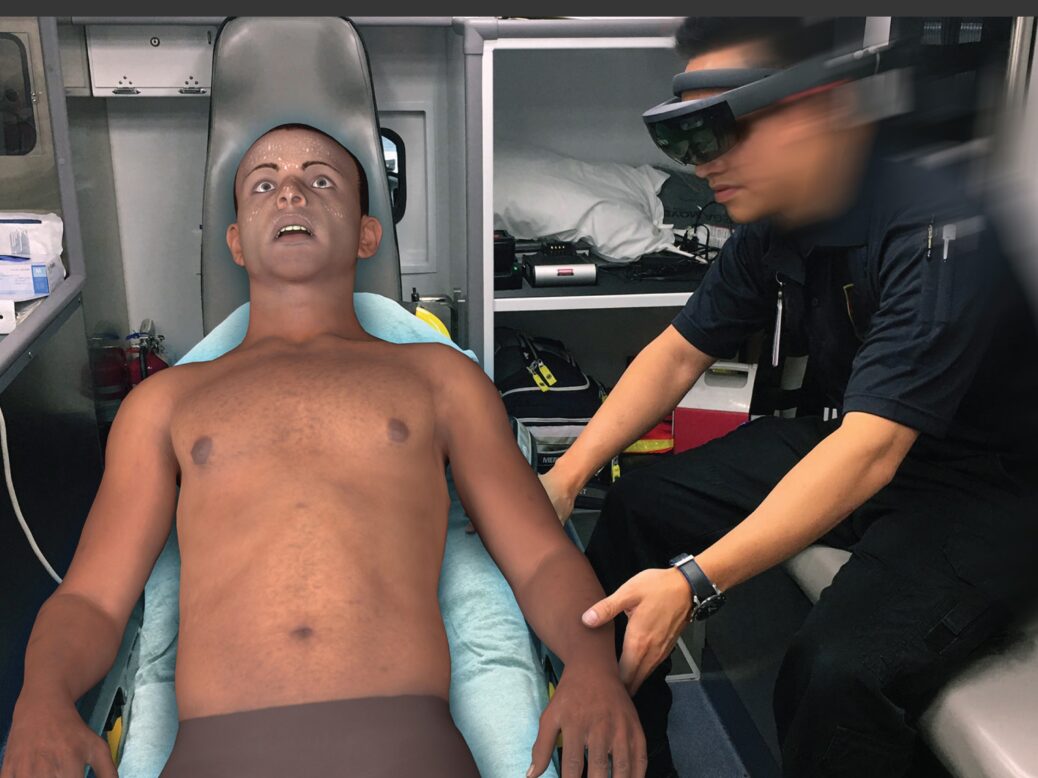 MedCognition’s PerSim | Augmented Reality Statistics
MedCognition’s PerSim | Augmented Reality Statistics
AccuVein is another AR-powered healthcare example.
With the help of augmented reality, the application revolutionizes the way hospital workers deal with IV (intravenous injection). The solution reduces potential human errors and failures to find and inject patients’ veins error-free.
The working scenario is simple: AccuVein scans a patient’s skin and accurately visualizes veins to conduct an injection.
These augmented reality statistics and examples show that the AR healthcare industry is thriving and growing from a $610M market size in 2018 to $4B by 2026.
12. 25% of retail companies utilize AR in business to boost sales (ThreeKit)
Retail companies are actively adopting AR-based solutions to empower their business.
Virtual try-ons, real-time customizations, augmented showrooms, and AR marketing help retailers accelerate their growth.
For example, IKEA Place.
The world-leading multinational ready-to-assemble furniture retailer launched a new IKEA Place app with an immersive virtual try-on feature. It lets customers find the desired item from a 2,000-sized catalog, and virtually furnish their apartments to see whether it fits physically and aesthetically.
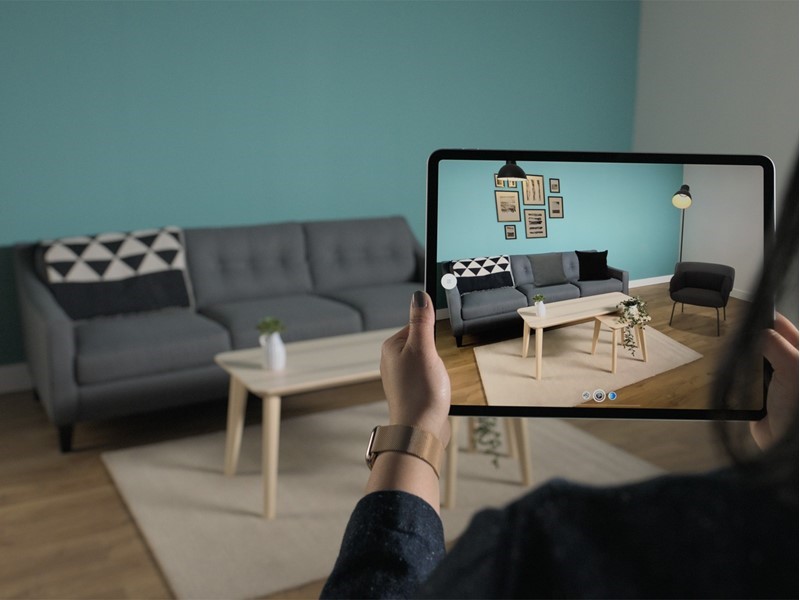 IKEA Place | Augmented Reality Statistics
IKEA Place | Augmented Reality Statistics
AR algorithms automatically scale the chosen furniture item to the dimensions of customers’ apartments with 98% accuracy. Also, the app allows users to see the texture of the fabric and visualize lights and shadows.
IKEA became a market pioneer in adopting AR capabilities in that specific way reporting to boost in-app sessions and reduce the product return rate.
Lego is another powerful example of using AR in the retail augmented reality industry.
The world’s largest toy company (as of 2021) launched its Lego Hidden Side AR app during the pandemic. It was designed to engage customers by making bundle elements live.
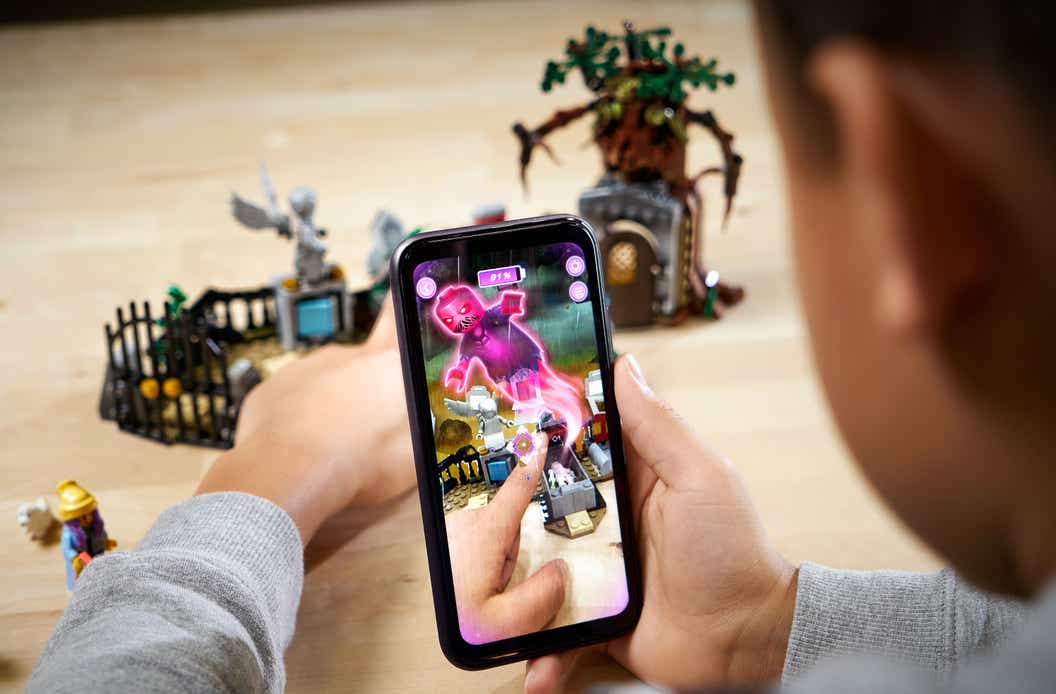 Lego | Augmented Reality Statistics
Lego | Augmented Reality Statistics
Kids installed an app and played a ghost-hunting game matching their mobile device cameras with the bundles. This creative AR adoption initiative became a retail market boom and increased LEGO sales by times.
Facts About Augmented Reality: 3 Investment Stats
13. $18B was invested in AR/VR technologies in 2020. (ThreeKit)
The AR industry is growing in a fast-paced manner. The IDC report states that the global amount of investments increased by 79% from 2019 showing $18.8B in 2020.
That’s reasonable as brands are looking for new ways to deliver high-engaging experiences to customers and win the competition. In turn, consumers are becoming more demanding daily and mostly opt for those businesses that offer the best engagement points in shopping.
14. 2,800 companies as AR startups on the Angel list. (Angel)
Another valid proof of the fast-growing AR industry is the number of augmented reality tech startups.
As of 2022, the number of AR-powered tech startups listed on the Angel list is 2,825.
15. 10,000+ VR/AR patents are owned by Microsoft. (Statista)
Despite the relatively low level of adoption rate for AR and VR devices, multiple businesses still invest decent funds and patent their solutions.
Microsoft is among the largest backer with over 10,000 AR/VR patents across many niches.
AR Facts: 5 Successful Use Cases
16. 81.91% was the uptake of a direct mail received rate spotted by SAP. (EngineCreative)
The largest non-American software company by revenue, SAP leveraged AR-enabled technologies in their direct mailing solution. Augmented reality helped deliver custom-designed SAP mugs to the market.
Simply, AR-powered solutions highlighted the range of SAP creative services in an interactive and engaging way. With an average benchmarked dwell time of 1 minute, SAP experienced an 81.91% boost in direct mail received rate in their marketing campaign.
The SAP example is among the valuable facts about AR showing that even tech and software companies can benefit from adopting augmented reality technologies in their business.
17. 50% sales boost was the result of adopting AR-based virtual try-ons by L’Oreal. (Forbes)
The world’s largest cosmetics company, L’Oreal decided to launch a brand-new AR-powered app StyleMyHair. The mobile experience allowed customers to try on multiple haircuts, colors, and styles in digital showrooms real-time before proceeding to checkout.
The app was based on a face tracking technology that segments and spots face shapes and hairstyles in real-time and lets users apply desired items virtually.
What’s more, location-based AR technologies helped the brand to implement a ‘salons near me’ experience. It guided users through the nearest beauty centers right after trying on their desired haircuts or colors.
This AR-powered approach helped the world-leading cosmetics brand increase sales by 50% in several months.
18. 700% user engagement increase was experienced by Ulta through AR-based virtual try ons. (Ulta)
Ulta Beauty, an American-based chain of beauty stores, was forced to close over 1,200 offline shops during the pandemic. This challenge stimulated the brand to launch GlamLab, a digital try-on feature-rich application.
The virtual experience enabled users to try on dozens of beauty products in real-time. In a year, the company reported spotting 19 million shade matches in 2020 and over 700% of in-app user engagement boost.
GlamLab remains the core digital sales strategy even now providing customers with immersive experiences along with over 1,000 reopened offline stores.
19. 30M Downloads in 3 months for Chignari app with AR-based Video Editor SDK. (Banuba)
Chingari, the most popular India-based social video sharing app, revolutionized the social media landscape in 2020. Followed by a TikTok ban in India, Chingari decided to bring its own market rival to life.
With the help of Banuba’s AR Video Editor SDK, the brand launched a social video sharing app that got over 550,00 downloads in just 10 days. Later on, Chingari experienced 30M app downloads in 3 months with an average session time of 7.5 minutes. The solution’s core augmented reality demographics are 18-35-year-old users mainly.
The company integrated our Video Editing SDK with animations and AR face filters. They allowed users to create and share short video content powered by:
20. 1M Installs for MNFST app with Banuba Face Filter SDK. (Banuba)
MNFST, a London-based lifestyle social media startup, launched its mobile app to revolutionize the influencer market. The core mission was to release a one-fits-all social marketplace for brands to promote their products and creators to monetize their content.
Integrating Banuba Face Filter SDK, MNFST has thrived in several markets experiencing over 1M installs, 50+ branded industry-leading partners, and over 750,000 published sponsored posts.
Nestle, Bolt, Vivid, Revolut, and Pockit were among the top brands using the MNFST app to run marketing and ad campaigns.
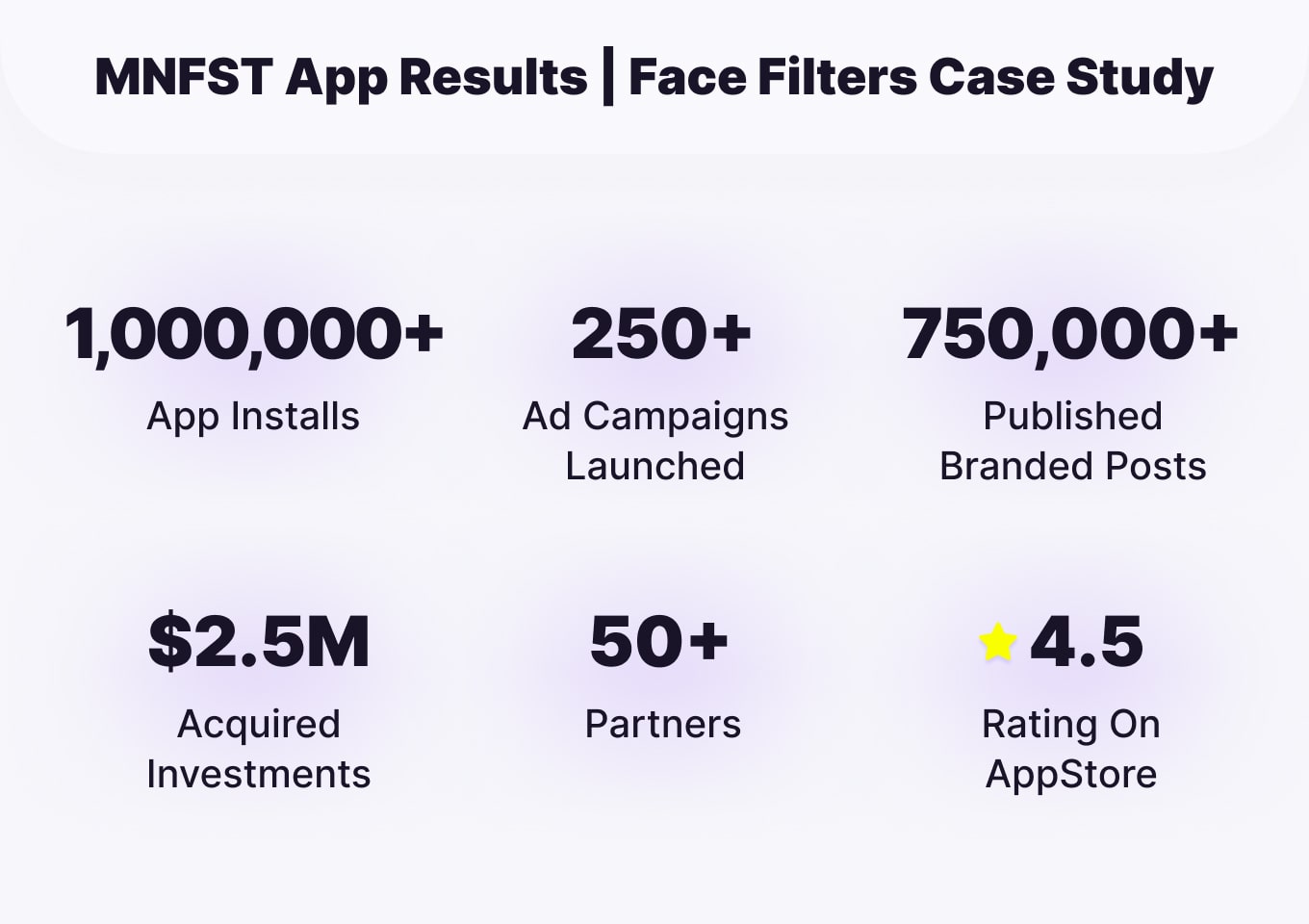 MNFST Results | Augmented Reality Statistics
MNFST Results | Augmented Reality Statistics
Wrapping Up
AR-powered solutions can enhance your business no matter what domain you operate in. Our guide on the mind-blowing facts about augmented reality shows multiple flourishing stories and use cases.
The provided augmented reality statistics should help you realize why and how you can benefit from adopting AR technologies in your specific case.
If you’re looking for powerful AR face filters or video editor solutions for your business, we’re here to help. Just request a 14-day free trial and start testing our industry-leading augmented reality solutions right away.
This content was originally published here.

